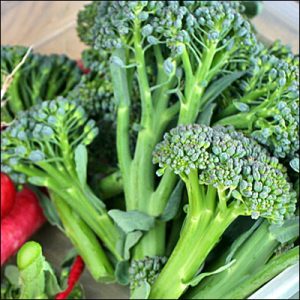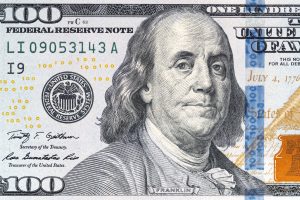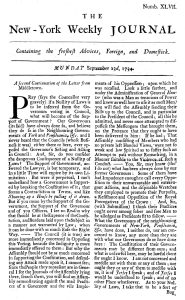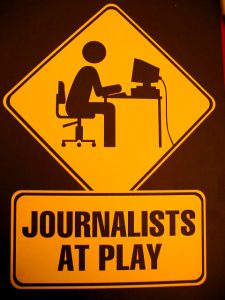1 Chapter 1: An Introduction
A Journalism Welcome
Welcome to the world of journalism. This textbook will introduce you to the field and provide you with the tools to write in a journalistic news style. We also will compare journalism to food, specifically broccoli and chocolate, because that helps with comprehension. More on that later.
First, a definition. Journalism is “the activity of gathering, assessing, creating and presenting news and information. It is also the product of these activities,” according to the American Press Institute, a nonprofit that supports journalists.
The Press Institute further explains the difference between journalism and other fields:
“Journalism can be distinguished from other activities and products by certain identifiable characteristics and practices. These elements not only separate journalism from other forms of communication, but they are also what make it indispensable to democratic societies. History reveals that the more democratic a society, the more news and information it tends to have.”
In other words, journalism deals with verified facts from experts and research and official documents, not speculation or opinion from someone on television or on social media. The lines between the two approaches have blurred over the years as technology has evolved. In this book, the focus is on writing and communicating facts and verified information in a traditional news form. We can leave the pontificating to the entertainers.
But even news writing can be entertaining. You will learn two kinds of news writing in this book: broccoli and chocolate news. Both are valuable and offer readers something to consume. They have slightly different formats and often widely different angles, but are both based on sound reporting and facts.
Think back to when you were young and you were faced with eating a healthy vegetable, like broccoli. You looked upon it with dread. Most people think broccoli is unappetizing but important to consume for their physical health. The broccoli type of journalism is providing readers with the informational nutrients they need in their diet. This textbook will teach you how to make broccoli more appetizing — add some cheese? — so your readers will want to consume it.

What do broccoli stories look like? Politics is an important example because what your government does affects your life and your finances. Road construction? You need to know how to avoid traffic. Whether a Walmart or skate park is built in your town? If you know the city is trying to decide between the two, you can tell its leaders how you want them to spend your tax dollars.
This book also will delve into chocolate news. The chocolate style of journalism is often feature stories. They are the feel-good, human-interest stories that do not help you as much but are much more fun to consume.

Examples of chocolate stories are features on people, sports game recaps and anything about celebrities. Will knowing who Taylor Swift is dating benefit your life? No, but neither will eating chocolate, and yet I still do. Your job as a journalist is to provide the right mix of broccoli and chocolate news.
Discussion questions
- What types of broccoli news do you consume?
- What types of chocolate news do you consume?
- Do you have a balanced news diet?
History of Journalism
When faced with a plateful of food, it’s best to eat the healthy stuff first.
Let’s consume the broccoli portion of this chapter while it’s still warm and you are still fresh. The broccoli in this chapter is the history of journalism. We will keep it brief but give you an overview of how journalism came to this country, according to the 1926 book “The History of Journalism in the United States” by George Henry Payne, a publisher who also managed the presidential campaign of Theodore Roosevelt in 1912.
The seeds of journalism came across the Atlantic Ocean via an English printer named William Brewster on the Mayflower in the 17th century. Before the ship even landed on American soil, Brewster and other passengers had drafted a document that first hinted at democracy, Payne writes.
This is important for new journalists to understand, that the skills learned in this book are crucial to the success of democracy. The early settlers in the New World understood this and spent the next few decades challenging England’s rules outlawing printed facts that made England look bad.
In 1690, for example, a man named Benjamin Harris came to America and produced the first newspaper on this continent, titled “Publick Occurrences, Both Foreign and Domestick.” It consisted of three pages with the last one left blank for readers to add their own information and pass it along. After only one edition, which contained an account of poor treatment of French prisoners of war, the publication was shut down by colonial authorities.
But as with today, the colonies still craved information. It came in the form of news and gossip distributed by postmasters in newsletters in the early 1700s. James Franklin, the brother of Benjamin Franklin, was a printer for other publications until he created his own, the New England Courant, in 1721.
Franklin leaned on his friends and his brother to contribute articles critical of the establishment. These writers earned the nickname the Hellfire Club from local clergy. Sound familiar? Hellfire Club was also the name of a group of students in the television series “Stranger Things.”
The concept of journalists “raising hell” and pushing back against authority is still a mantra of journalism today.
James Franklin was soon banned from printing, leaving 16-year-old Benjamin Franklin – who wrote under the pen name Silence Dogood – to take over as printer. Similar struggles were happening in New York, Boston and Philadelphia as the New World rose up against the rules and restrictions of the old one.

This tension came to a head with a German printer named John Peter Zenger, who founded the New York Weekly Journal in 1730 and published pieces critical of the governor. Zenger was arrested and charged with libel, or damaging the reputation of the governor. Poor and unable to post bail, Zenger continued to edit and print the newspaper from prison during the nine months he awaited trial.

This began the ultimate test for whether journalism could survive in America.
To everyone’s shock, wealthy and successful lawyer Andrew Hamilton took Zenger’s case and argued against an English law that forbade citizens from expressing negative opinions about their government. Hamilton contended that people should have the right to hold government accountable. The jury agreed, and Zenger was found not guilty. This was the first legal case that protected free speech and freedom of the press.
“The trial of Zenger was the forerunner of the great struggle of the revolution,” Payne writes in his book. “It was the greatest battle fought on this side of the water for a free press and a greater journalism.”
Of course, there is much more history to the story of journalism in America. But the most important takeaway is this: All of the work of the past led to the First Amendment, which reads: Congress shall make no law respecting an establishment of religion, or prohibiting the free exercise thereof; or abridging the freedom of speech, or of the press; or the right of the people peaceably to assemble, and to petition the Government for a redress of grievances.
The biggest lesson from journalism history is that each journalist has an obligation to the truth, no matter what. Your fellow students are doing that kind of work all over the country.
Why Journalism Matters
Here is some chocolate, a feel-good but important story about college students like you who made a difference through their journalism skills.
The Associated Press is an almost 200-year-old company that reports around the world and whose work is used by other media organizations. AP writer David Bauder reported on Oct. 12, 2023 about college journalism students who used the skills you will find in this textbook to effect change in their universities. Consider his lead:
Example:
NEW YORK (AP) — Within the past year, young journalists have produced investigations that led to the resignation of Stanford University’s president, the firing of Northwestern University’s football coach, and a school shooting graphic so striking that it led a veteran newsman to say, “I’ve never seen a better front page.”
All while making sure to get their homework in on time.
The students profiled in Bauder’s story followed the tenets of journalism. They uncovered and published facts even when faced with death threats and shunning by some in their college community. They felt a dedication to the truth despite obstacles and resistance, and conveying that information to the public made the world a little better.
The experiences of those students are extreme, but journalism skills can be applied in any college setting. The Telescope, the student-run newspaper of Palomar College in North San Diego County, once invited every person running for a seat on the school’s governing board to come to campus and answer questions. One candidate kept talking about race-based admissions. The Telescope editors listened and then used their critical-thinking skills to question why a candidate would focus on race-based admissions at a community college where everyone is accepted.
The Telescope staff then wrote about the Q&A, including the fact that the candidate had never set foot on campus except for the interview and to take a campaign picture. They explained to readers that the candidate admitted that he was referring more to four-year schools, but that he thought he should start at Palomar.
The candidate lost the election due in part to the campus newspaper, its staff using journalism skills to make sure voters understood why every candidate was running for a seat on the college’s board.
What you can do as a journalism student matters. You have the ability to uncover truth and shed light on issues that impact yourself and your fellow students. You can make your life and the lives of others better by the skills you learn in this book.
As a student journalist, you can have a built-in audience through your college newspaper, blog or social media accounts. This public megaphone is a privilege available to you by virtue of being a college student in the U.S. Don’t waste it on unimportant chocolate news that’s discussed time and time again (looking at you, celebrity relationships). Instead, spend the time and energy needed to report on student homelessness or a classmate who just won a national award. Look for the stories that impact your college and your world.
Critical Thinking
Critical thinking is a buzzword that shows up in many college classes. Critical thinking is “careful thinking directed to a goal,” according to a 2018 study by Stanford. It is an educational goal “on the basis of respect for students’ autonomy and preparing students for success in life and for democratic citizenship.”
The ability to think carefully is helpful in life, but essential in journalism. The Poynter Institute, a nonprofit journalism think tank, published an article in 2005 by Jill Geisler, who interviewed 35 experts to create a list of journalism-specific skills for critical thinking:
- Thinking independently
- Exercising fair-mindedness
- Exploring thoughts underlying feelings and feelings underlying thoughts
- Refining generalizations and avoiding simplifications
- Clarifying issues, conclusions or beliefs
- Clarifying and analyzing the meanings of words and phrases
- Developing criteria for evaluation; clarifying values and standards
- Evaluating the credibility of sources of information
- Analyzing or evaluating arguments, interpretations, beliefs or theories
- Generating or assessing solutions
- Reading critically
- Listening critically
- Examining or evaluating assumptions
- Distinguishing relevant from irrelevant facts
- Making plausible inferences, predictions or interpretations
Geisler also wrote some questions that encourage critical thinking:
- What assumptions do you have about the issues or individuals in your story?
- Is there another plausible explanation we should look at in this case?
- Have you worked as hard to disprove as to prove your hypothesis?
- What is missing here? Are we asking the right questions?
- Are we really challenging ourselves? Are we falling in love with our story as we see it now?
- Why is this information relevant to the story?
- Are we assuming that correlation is causation?
- How closely did we listen to all voices?
- Are we letting fear drive our thinking?
- Just because it has always been done this way before, is that a reason not to question?
- Just because we had a difficult time getting this information, does it make it particularly important or interesting?
- Do we have the expertise in this subject to form an appropriate conclusion? Is there more we need to learn?
- Are we oversimplifying or overgeneralizing?
- How is our logic? Are we falling prey to ad hominem arguments (personal attacks) or false dichotomies (mistaken belief that there are only these two options) instead of examining the issue more completely?
- Is this really fair?
A good journalist will keep this list posted wherever they write to remind themselves to never stop asking questions.
Consider an Illinois journalist who asked so many questions that he was fined by the city he covered, according to a New York Times article by Rebecca Carballo in November 2023. Her lead:
Example:
Officials in a Chicago suburb on Monday said that their city would dismiss citations that it had issued to a local news reporter in late October after he persistently contacted elected officials about a flooding issue.
The Daily Southtown, a regional newspaper owned by the Chicago Tribune Media Group, the parent company of The Chicago Tribune, published an article by Hank Sanders about consultants informing officials in Calumet City, Ill., that storm water facilities were in “poor condition” before a flood swept through the community in September.
The reporter sent 14 emails in nine days to city officials after a flood swept through the area. The reporter was investigating the deteriorated condition of the storm water facilities that contributed to the flood. The city officials did not want to talk about it, and the city attorney cited and fined the reporter.
The newspaper’s lawyer fought back and publicized the reporter’s plight. The picture of a government trying to stop a reporter from asking questions earned national attention, including the article by the New York Times. The city caved.
Mitch Pugh, executive editor of The Chicago Tribune, told the Times, “It’s clearly an attempt to intimidate and interfere with his reporting.”
The reporter’s critical-thinking skills and tenacity shed light on a problem with the city’s storm system that could save the community from a future flood.
Broccoli/Chocolate
Many students who begin journalism studies yearn for chocolate. They want to start a YouTube channel to talk about the newest beauty products, or they love football and want to be on TV talking about the big game. This is chocolate news of the highest order, where opinion is a large part of the message.
Though chocolate in nature, these pursuits still require the foundational journalism skills taught in this book. The person who reviews a new film has done their research on cinematography, lighting and directorial debuts. The person who analyzes a game has spent hours poring over statistics, interviewing coaches, and studying players’ tapes before going on air.
The broccoli skills taught in this book will allow you to transfer to the next level of classes in most college journalism, public relations, and broadcast and radio programs. It also will help you to determine if you like this kind of research, reporting and writing.
Society needs people like you to write news in a fact-based way. Readers need journalists who will stand in as a “news parent” and make them eat their broccoli. Look no further than Donald Trump and his presidency that started in 2017. His unpredictable behavior made for interesting political coverage. Newspaper and media organizations saw a substantial uptick in readers and viewers while Trump was in office.

A Wall Street Journal article by Benjamin Mullin and Alexandra Bruell in December 2021 reported that the Washington Post “experienced an audience surge during the Trump years, when readers flocked to stories about the controversial Republican administration.”
When Trump left office in 2021, the Post website had about 66 million monthly unique visitors that October, down 28% from the previous year. Trump made politics more fun to consume. When he left, many readers did, too.
That means journalists must work harder to make that broccoli news more edible. We must provide our readers with a mix of stories to keep them coming back to the media table.
The Future
There always will be a need for broccoli and chocolate news. The ways that readers consume news have changed throughout history, from early newspapers to links in the bio of an Instagram feed. Statistics show that people increasingly will get their news through digital formats.
The Pew Research Center released a State of the Media report in November 2023. The data reveals that physical newspapers will continue to decline in the face of competition from the internet and social media. In 2022, according to the report, estimated total U.S. daily newspaper circulation (print and digital combined) was 20.9 million for both weekday and Sunday, down 8% and 10% respectively from 2021.

Podcasting, which includes news-oriented audio programs based on reporting and verified facts, has surged in the last decade. In 2023, 31% of people 12 and older said they had listened to a podcast in the last week, up from 26% in 2022 and 7% when Pew started tracking the trend in 2013.
But digital is where the readers have gone, according to Pew.

“The vast majority of adults in the United States get at least some news from digital devices, and the online space has become a host for the digital homes of both legacy news outlets and new, ‘born on the web’ news outlets,” Pew reported.
The number of people visiting those news sites has been stable since the Trump drop in 2021, from 27.9 million unique visitors that year to 27.1 million in 2022. It is important to note that the average visit was only 1 minute, 45 seconds, so readers do not stick around for long. This book will explore ways to write more effectively to keep your readers engaged.
Jeff McDonald, an investigative reporter for the San Diego Union-Tribune, has worked in the industry for 35 years. He says he’s optimistic for the future of journalism, even if traditional media outlets are changing rapidly.
“While the internet has surely disrupted American journalism, there will always be a market for news,” McDonald wrote in an email. “People like to know what their school board is doing and how their tax dollars may be misused.”
McDonald pointed to a genre of local news outlets that are online-only, as well as to the success of nonprofit media organizations that don’t need advertisers.
“Public media models like NPR and KPBS have shown that people are willing to pay for news, although they may be leaner than the heyday budgets that the U-T and other large metro dailies enjoyed for so long,” he wrote. “If we as a society ever get the social media outlets like Facebook, Apple and Google News to pay for even a slice of the content they routinely steal, then revenue streams will be enhanced and protected for years to come.”
Job Outlook
If you like journalistic writing, you may need to decide whether to pursue it as a career. Is it a smart move for you? Let us practice some journalism and do our research. The numbers suggest that although the medium is changing, the need for information remains.
The U.S. Bureau of Labor Statistics tracks jobs throughout the country. For journalism, the bureau included a video of the types of jobs it studies and found that the median pay was $55,960 in 2022.

The department noted that salary and job opportunities vary by state, with states like California having more opportunities and higher wages than its neighbors.
But journalism is a tough industry, with employment projected to decline 3% from 2022 to 2032. Despite this, the bureau reports that about 6,000 openings for news analysts, reporters and journalists are projected each year over the next decade.
Key Takeaways
- Journalism deals with verified facts from experts and research and official documents, and is designed to challenge authority. It has a long history of holding governments accountable and is essential to a democracy.
- A crucial skill for any journalist – and person – is the ability to think critically. That means thinking independently, verifying information from multiple sources, and challenging your own beliefs in the search for truth.
- The way people get their news has changed throughout history, and the future is digital. But the need for skilled reporters who are able to uncover and communicate information will never go away.
Chapter Exercise
Set some goals for yourself with this textbook. To help create course objectives, answer the following questions. Hold on to this, as you will need it at the end of the textbook.
- What do you want to learn from this textbook?
- What do you need to learn from this textbook?
- What are you most excited about?
- What are you dreading?
- What obstacles do you see for learning this information?
- How much time have you set aside for this work?
- Have you set a regular schedule for when you can focus on journalism? Why or why not?
